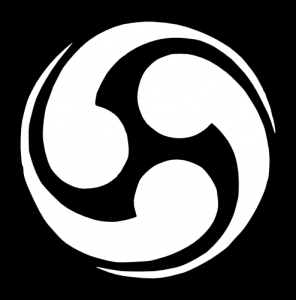Recreational research into Feudal Japan
Posts tagged Shimabara Rebellion
Element of the Week: Tomoe
Jul 26th (a Tomobiki (友引))
This week, we look at another religious symbol that’s a mite less controversial. The tomoe (巴) is a comma- or swirl-shaped design with a variety of possible origins. It resembles ancient Japanese curved jewels (such as the jewel that serves as one of the three Japanese imperial regalia).(en.wp:Tomoe) Other possible origins associate it with a wrist guard (tomo/鞆) used by archers, Chinese snake depictions and the ying-yang symbol. Although dating to the Nara period (710–794), it only became widely used in the tenth or eleventh century, but at that point it became immensely popular, becoming the second-most-popular motif for family mon by the start of the Edo period (1600). Whatever its origin, it developed additional meanings: its resemblance to a whirlpool caused it to be used to protect buildings from leaks, and it later developed general religious connotations and became specifically associated with Hachiman, Shintō god of war.(Dower:145–146)
Here are three tomoe crests, each using three tomoe, the most popular number. From left to right, a crest used by Maeda Toshiie at the Siege of Suemori in 1584,(SH:F4) one used by Kobayakawa Takakage at the Battle of Pyokje, Korea in 1593,(SH:60) and one used by Itakura Shigemasa at Shimabara in 1638.(SH:J9)
Element of the Week: Swastika
Jul 19th (a Senshō (先勝))
Today we discuss a controversial mon element (and one you definitely cannot use in the SCA): the swastika. The swastika (卍 or 万字/manji), among many other symbolic uses, has always represented Buddhism in Japan, a use that dates back to the 5th century BCE in India. In Buddhism, the swastika represents dharma, harmony, and the balance of opposites.(en.wp:Swastika) Its use in Japan dates back to Buddhist use in the Nara period (710–794), and it acquired additional auspicious connotations due to phonetic associations with the word “man” (万), meaning “ten thousand”, and the idea of the virtues held by a Bodhisattva.(ja.wp:卍) After Christianity was banned following the Shimbara Rebellion in 1638, this was one of several mon popular among the “hidden Christians” who continued practicing in secret due to its subtle cross-shape.(Dower:148) Even in modern Japan, Buddhist temples are indicated on maps with a swastika icon. (While the Japanese swastika today generally points left, unlike the Nazi right-pointing swastika, both directions were used historically.) Due to the distance between Japan and Germany and Japan’s own wartime government basing its legitimacy on Shintō, not Buddhism, the fascist connotation is mostly absent.
Of course, in the Sengoku period, Buddhist connotations were the only connotations known to the Japanese, and samurai who wanted to display their religious faith might choose the swastika from the many religious symbols used in mon. Here we have two examples: the mon used by Tsugaru Nobuhira at Hirosaki Castle in 1610, and that used by Hachisuka Iemasa, who died in the Shimabara Rebellion in 1638.(SH:I,62) While the image of armies of soldiers marching with swastikas painted on their helmets may seem alarming today, it was no different than marching under the Christian cross in Europe.





